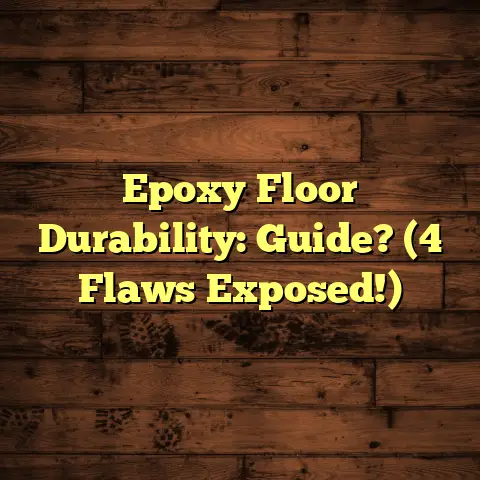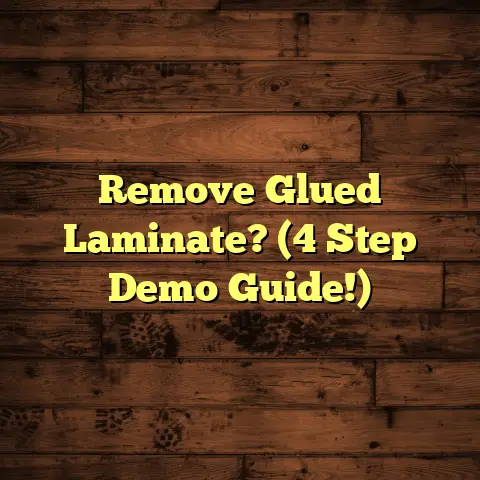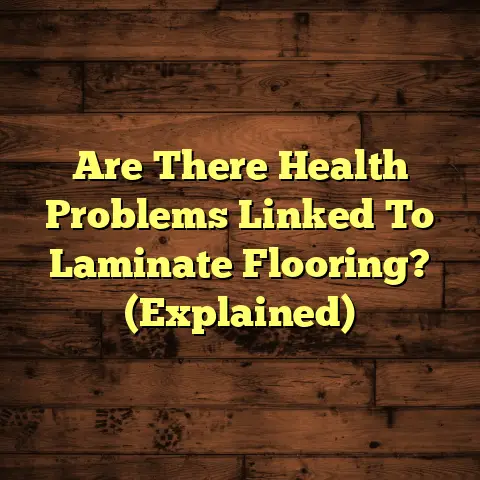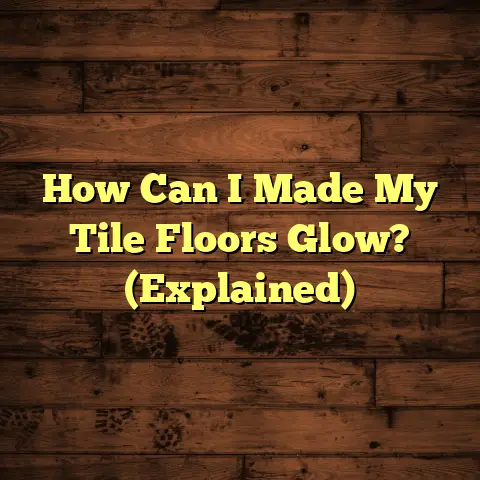Mold on Concrete?! (9 Things To Know)
It’s not just an eyesore, folks. Mold can be downright dangerous. We’re talking health risks, structural damage, the whole shebang.
Think of it like this: your concrete is the foundation of your home. You want to keep it strong, right? Well, mold is like a sneaky termite, slowly eating away at that foundation.
So, let’s dive into the nitty-gritty. We’ll cover everything you need to know about mold on concrete, from what it is to how to kick it to the curb.
1. What is Mold and How Does it Grow?
Okay, let’s get sciency for a sec. Mold is a type of fungus. Specifically, it’s a multicellular filamentous fungi, and it thrives in damp environments. It reproduces by releasing tiny spores that float through the air.
Think of them like microscopic seeds. When these spores land on a surface with the right conditions – moisture, warmth, and food – they start to grow.
Concrete itself isn’t exactly a buffet for mold, but the dust, dirt, and organic matter that accumulate on it? That’s mold’s favorite dish.
Here’s the key takeaway: mold needs moisture to survive. Without it, those spores stay dormant. But give them a little water, and they’re off to the races.
2. Common Causes of Mold Formation on Concrete
So, where does this moisture come from? Good question! Here are some of the usual suspects:
-
Leaks: A leaky pipe, a dripping faucet, or a roof that needs some TLC can all introduce moisture to your concrete.
-
Flooding: This one’s obvious, but even a minor flood can leave behind enough moisture to fuel mold growth.
-
Humidity: High humidity, especially in basements and crawl spaces, can create a breeding ground for mold.
-
Condensation: Ever notice how your concrete floor gets damp in the summer? That’s condensation, and it’s mold’s best friend.
-
Poor Ventilation: Stagnant air traps moisture. Good ventilation helps to dry things out.
I’ve seen cases where a simple landscaping issue – like overgrown bushes blocking airflow around the foundation – was enough to cause a mold problem. Crazy, right?
3. Signs of Mold Presence on Concrete
Alright, how do you know if you’ve got a mold problem? Here are some telltale signs:
-
Visual Indicators: This is the most obvious. Look for discoloration, black spots, green fuzz, or a slimy texture on your concrete.
-
Musty Odors: That distinctive, earthy smell? That’s mold. If you smell it, even without seeing anything, investigate further.
-
Allergy Symptoms: Are you suddenly sneezing more often? Do you have itchy eyes or a stuffy nose? Mold could be the culprit.
-
Water Stains: Water stains on your concrete can be a sign of past or present moisture issues, which can lead to mold.
Don’t just rely on your eyes. Get down on your hands and knees and sniff around. Use a flashlight to check dark corners and hard-to-reach areas. Trust me, mold loves to hide.
4. Health Risks Associated with Mold Exposure
Okay, this is where things get serious. Mold isn’t just ugly; it can make you sick.
-
Respiratory Issues: Mold spores can irritate your lungs and airways, leading to coughing, wheezing, and shortness of breath.
-
Allergies: Mold is a common allergen. Exposure can trigger allergic reactions like sneezing, runny nose, and skin rashes.
-
Asthma: Mold can worsen asthma symptoms and even trigger asthma attacks.
-
Toxic Effects: Some types of mold, like Stachybotrys chartarum (black mold), can produce mycotoxins, which can be harmful to your health.
According to the CDC, mold exposure can cause a variety of health problems, and people with weakened immune systems, allergies, or respiratory conditions are particularly vulnerable. (Source: CDC Website)
I’ve seen families forced to move out of their homes because of severe mold infestations. Don’t let that happen to you.
5. Impact of Mold on Concrete Structures
Mold doesn’t just affect your health; it can also damage your property.
-
Structural Damage: Mold can weaken concrete over time, especially if it’s growing in cracks or pores.
-
Foundation Problems: Mold can contribute to foundation problems by trapping moisture and accelerating the deterioration of the concrete.
-
Reduced Property Value: A mold infestation can significantly reduce the value of your home.
-
Costly Repairs: Addressing mold issues can be expensive, especially if the damage is extensive.
I remember one job where we had to replace an entire section of a concrete foundation because of mold damage. The homeowner had ignored a small leak for years, and it ended up costing them thousands of dollars.
6. How to Identify Mold on Concrete: A Step-by-Step Guide
Alright, let’s get practical. How do you actually identify mold on concrete?
-
Gather Your Tools: You’ll need a flashlight, a scrub brush, a spray bottle, and some protective gear (gloves, mask, and eye protection).
-
Inspect the Area: Start by visually inspecting the concrete for any signs of mold. Look for discoloration, spots, or fuzz.
-
Sniff Around: Use your nose to detect any musty odors.
-
Test the Surface: Spray a small area of the suspected mold with water. If it darkens and becomes slimy, it’s likely mold.
-
Differentiate from Mildew: Mildew is a surface fungus that’s usually white or gray. Mold is more likely to be black, green, or brown.
-
Consider a Mold Test: If you’re unsure, you can purchase a mold test kit at your local hardware store or hire a professional mold inspector.
Remember, safety first! Always wear protective gear when inspecting for mold.
7. Mold Prevention Strategies for Concrete Surfaces
The best way to deal with mold is to prevent it from growing in the first place. Here are some tips:
-
Control Humidity: Use a dehumidifier to keep humidity levels below 60%.
-
Improve Ventilation: Open windows and doors to increase airflow. Use fans to circulate air.
-
Fix Leaks: Repair any leaks promptly.
-
Proper Drainage: Make sure your gutters and downspouts are working properly to divert water away from your foundation.
-
Landscaping: Trim bushes and trees to allow for better airflow around your foundation.
-
Regular Cleaning: Clean your concrete surfaces regularly to remove dust, dirt, and organic matter.
I always tell my clients that prevention is key. A little bit of effort now can save you a lot of headaches (and money) down the road.
8. How to Safely Remove Mold from Concrete
Okay, so you’ve found mold. Now what? Here’s how to remove it safely:
-
Gather Your Supplies: You’ll need gloves, a mask, eye protection, a scrub brush, a spray bottle, and a mold-killing solution.
-
Ventilate the Area: Open windows and doors to provide ventilation.
-
Apply the Solution: Spray the moldy area with your chosen cleaning solution.
-
Scrub the Surface: Use a scrub brush to scrub the mold off the concrete.
-
Rinse Thoroughly: Rinse the area with clean water.
-
Dry the Surface: Use a fan or dehumidifier to dry the area completely.
Cleaning Solutions:
- Bleach: A diluted bleach solution (1 part bleach to 10 parts water) is effective at killing mold.
- Vinegar: White vinegar is a natural mold killer.
- Borax: Borax is another natural option. Mix 1 cup of borax with 1 gallon of water.
- Commercial Mold Cleaners: There are many commercial mold cleaners available at your local hardware store.
Safety Tips:
- Always wear protective gear when removing mold.
- Never mix bleach with ammonia or other cleaning products.
- Work in a well-ventilated area.
Remember, if the mold infestation is extensive, it’s best to call a professional.
9. When to Call Professionals
Sometimes, DIY just isn’t enough. Here are some situations where you should call a mold remediation professional:
- Extensive Mold Growth: If the mold covers a large area (more than 10 square feet), it’s best to leave it to the pros.
- Health Concerns: If you have health concerns related to mold exposure, consult a doctor and a mold remediation specialist.
- Structural Damage: If you suspect that the mold has caused structural damage, call a professional engineer or contractor.
- Recurring Mold: If you keep getting mold even after cleaning it, there may be an underlying moisture problem that needs to be addressed by a professional.
Choosing a Reputable Company:
- Get Recommendations: Ask friends, family, or neighbors for recommendations.
- Check Credentials: Make sure the company is licensed and insured.
- Read Reviews: Check online reviews to see what other customers have to say.
- Get Multiple Quotes: Get quotes from several companies before making a decision.
I’ve worked with some amazing mold remediation companies over the years. They have the expertise and equipment to handle even the toughest mold problems.
Conclusion
So, there you have it. Everything you need to know about mold on concrete. Remember, mold is a serious issue that can affect your health and your property.
Stay vigilant, take preventive measures, and don’t hesitate to call a professional if you need help.
Keep your home safe and mold-free! And if you ever need a flooring guy, you know who to call!





